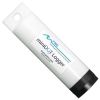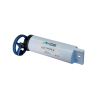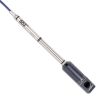PME miniDOT Clear Dissolved Oxygen Logger
Features
- Portable, completely submersible, easy to operate
- User replaceable batteries and long lasting in the field
- Also records time, date, and battery voltage
- Expedited repair and warranty service
- Lifetime technical support
- More
Overview
The PME miniDOT Clear Dissolved Oxygen Logger is a completely submersible instrument that logs dissolved oxygen and temperature measurements with an internal LCD screen for accessing the latest readings. It includes an optical DO sensor, a temperature sensor, batteries and a micro SD memory card. Data are recorded internally with a sample interval from once per minute to once per hour and can be offloaded to a computer via USB cable.
Data Collection
The oxygen sensor is an optode that measures dissolved oxygen concentration in water through a fluorescence method. The sensing foil contains a coating that has a variable fluorescence that depends upon oxygen concentration in the surrounding water. The sensor is able to compute oxygen concentration in mg/L and record these measurements internally. Each logger is factory-calibrated at 12 oxygen concentrations, each at 8 temperatures, for a total of 96 calibration points.
In The News
From Paddles to Phytoplankton: Studying Vermont’s Wildest Lakes
For six months of the year, Rachel Cray, a third-year PhD student at the Vermont Limnology Laboratory at the University of Vermont, lives between a microscope and her laptop, running data. For the other six months, she is hiking and canoeing four of Vermont’s lakes, collecting bi-weekly water samples. Cray studies algal phenology across four lakes in Vermont, US, that have low anthropogenic stress—or in other words, are very remote. Funded by the National Science Foundation Career Award to Dr. Mindy Morales, the lakes Cray researches part of the Vermont Sentinel Lakes Program, which studies 13 lakes in the area and, in turn, feeds into the Regional Monitoring Network, which operates in the Northeast and Midwest US.
Read MoreReimagining Water Filtration: How Monitoring and Science Enhance FloWater Filtration Systems
Over 50% of Americans think their tap water is unsafe , according to the Environmental Working Group (EWG). Other recent surveys have found that number to be as high as 70% of persons surveyed. Whether due to increased public awareness of water quality issues or confusion about how municipal water sources are regulated, there is a clear distrust of tap water in the United States. According to industry expert Rich Razgaitis, CEO and co-founder of the water purification company FloWater, this issue creates a damaging cycle. Razgaitis explained that the health and environmental problems associated with contaminated water aren’t the only issues. As people become increasingly aware that some tap water is unsafe, they resort to bottled water.
Read MoreMonitoring New Hampshire’s Aquatic Ecosystems: Continuous Data Collection in the Lamprey River Watershed
New Hampshire’s aquatic ecosystems provide a range of ecosystem services to the state and region. Resources and services like clean water, carbon storage, climate regulation, nutrient regulation, and opportunities for recreation all depend on New Hampshire’s aquatic ecosystems remaining healthy. Jody Potter, an analytical instrumentation scientist at the University of New Hampshire (UNH), is studying these aquatic ecosystems in hopes of developing an improved understanding of ecosystem services and their interactions with climate change, climate variability, and land use changes. [caption id="attachment_39799" align="alignnone" width="940"] Aquatic sensors in the Merrimack River in Bedford, NH, with I-293 in the background.
Read More
















